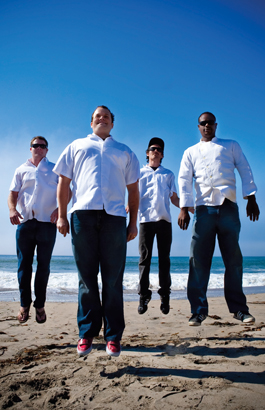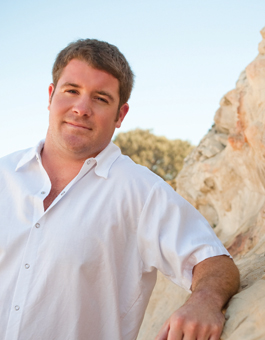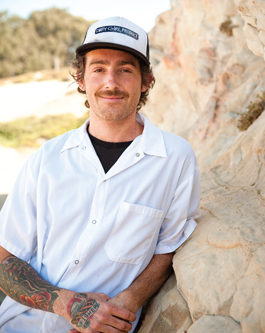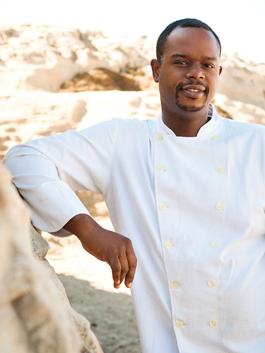home | metro santa cruz index | features | santa cruz | feature story

Photograph by Carlie Statsky
Stock Stars: From left to right, Santa Cruz chefs Charlie Parker of Cellar Door Cafe, Ben Sims of Avanti, Brad Briske of Gabriella Café and Damani Thomas of Oswald.
The Art of The Meal
The first Santa Cruz Restaurant Week gives curious newbies, fussy foodies and appreciative regulars the chance to try something new
Profiles by Stett Holbrook and Christina Waters
IT WAS JUST a matter of time before Santa Cruz joined the ranks of cities across the country celebrating local culinary talent with Restaurant Week. In New York, Boston, Los Angeles and San Diego, chefs were joining together for a week each year to entice diners out of their routines and into cosmopolitan restaurants where they might discover exotic new flavors and textures. And those cities are not the cradle of sustainable produce or home to unique viticultural appellations.
This was the topic of conversation one July afternoon at the Cellar Door Cafe in the Bonny Doon Vineyard tasting room, where Dan Pulcrano, president of Metro Newspapers, sat shooting the breeze with newly installed chef Charlie Parker. The two agreed that if those cities could do a restaurant week, Santa Cruz could too. It has the talent, it has the terroir. It's becoming a dining destination in its own right as skilled chefs and winemakers set up shop, drawn by the local produce and natural beauty. Parker suggested putting on a Restaurant Week sooner rather than later, and a plan quickly began to form.
The first Santa Cruz Restaurant Week runs eight days, from Oct. 1 to Oct. 8, and features $25 prix fixe menus from two dozen restaurants. That means that for a fraction of the price of three a la carte courses, diners can sample a trio of dishes from each establishment and in the process maybe discover a new favorite restaurant or remember the charms of an old one. It's a time to step out, experiment and push the boundaries--just like the talented chefs who are making this week possible.
Charlie Parker
Cellar Door Cafe
On the Menu: Slow-roasted pork shoulder with pecorino polenta and braised greens, whole fried rock cod with sweet corn, roasted dry-farmed tomato soup with torn bread and crème fraîche.

Photograph by Carlie Statsky
You're A Good Chef, Charlie Parker: Working at two Michelin-starred restaurants taught the Cellar Door chef the sanctity of good ingredients.
DURING his three-month stint at Noma, a two-Michelin-star Danish restaurant regarded as one of the best in the world, Charlie Parker realized he'd had enough of fine dining restaurants. Eating in other star-bestowed restaurants around Europe added to the feeling.
"It didn't seem as fun anymore," he said. "It was too stuffy to my liking."
Parker, 26, has been cooking for nearly 10 years. He is soft-spoken with short-cropped hair and built like a linebacker, stout and strong. In fact, he was a middle linebacker in high school and still looks like he could maul his way through a heavily fortified offensive line. From a young age he's had a passion for cooking.
"By the time I was in the fourth grade I would go straight home and watch Great Chefs of the West," he says, referring to the late, great public television cooking show. He served as short order cook for his family, whipping up snacks and sandwiches before tackling dinner. He got his first job in a professional kitchen at 17 and has been cooking ever since.
"[Cooking] is something you'll never know enough about," he said. "I'm constantly learning."
The Menlo Park native had previously cooked at top Bay Area restaurants like Manresa, Ubuntu and the Village Pub when he headed off for an internship at the famed Copenhagen restaurant in January. While he valued his experience at Noma, he longed to work at a more casual restaurant that served great food, but where it was OK to relax with friends and get a little loud--a combination he says can be hard to find. And then he got an email from Manresa's David Kinch. Kinch, who had groomed Parker from a green California Culinary Academy extern into his sous-chef, was offering him a job as executive chef at Bonny Doon Vineyard's new Cellar Door Cafe. Kinch had teamed up with Bonny Doon's Randall Grahm to revamp the cafe-within-a-tasting room, and he thought Parker would be perfect for the job.
At Manresa, Kinch had been impressed by Parker's discipline, hard work and commitment to letting the quality of the ingredients shine rather than flexing his technique to render his own personal stamp on the food. "For a young cook, he has fully grasped that the quality of ingredients is paramount to what you do," says Kinch.
The economy stinks now, but last winter it was apocalyptic, so a job offer was compelling. But just as appealing to Parker was the fact he would be able to cook the kind of rustic-yet-refined food he loved in a more convivial setting.
"Of course I accepted it," he said. By April he was on the job in Santa Cruz.
Like a parent watching children leave home and start lives of their own, Kinch takes great pleasure in seeing his former cooks strike out on their own. Two Manresa alumni started Ubuntu, a high temple of vegetarian cuisine. Former Manresa chef de cuisine James Syhabout recently opened Commis in Oakland to sensational reviews. And now Parker has left Manresa nest to run his own place.
You might think that as a disciple of Kinch working for Grahm, Parker's cooking would be pretty out there. Kinch is one of the most inventive and forward-thinking chefs in the world, while Grahm is one of the world's most iconoclastic winemakers. Although I see influences of Manresa in Parker's cooking, such as his use of flowers and fruit in savory courses, his cooking is wholly his own.
He favors the big, generous flavors of Spain and Italy but brings techniques he's learned from his diverse culinary background to bear on the ingredients. On the plate his food appears perfectly thrown together. To watch Parker in the spare, open Cellar Door kitchen is to see him composing each dish to achieve a nonchalant yet artfully put-together look.
Good chefs also need to be more than deft cooks; they need to know how to work the room. And Parker does. Grab a seat at the bar and you'll see him mix it up with customers and talk to them about his food, often serving them personally.
As a chef, Parker is inspired by the seasons and locally sourced produce--just like every other chef in America. What makes his approach different, he says, is that the products he serves are truly local. Most come from within 10 miles of the kitchen door.
"I'm blessed in this area to have some of the best produce in the world," he says. "It's such a privilege to cook in this area."
Because he's developed good relationships with local growers, his ear is close to the ground, and he has an intimate knowledge of what's available and what's soon to be in season. As such, his three-course prix fixe menus change daily but are planned out two weeks in advance. Add in a chalkboard menu of snacks and small plates that change regularly, and you get a fleeting moment of local flavor framed on a plate.
A recent menu offered a snapshot of late summer fecundity. Silken, rich bowls of roasted dry-farmed tomato soup. Pan-roasted local squid with heirloom tomatoes, grilled melon and puréed mint. Pan-fried padrón peppers with smoked chèvre in a basil bud vinaigrette. My favorite was the grape-marinated kampachi with fire-blistered grapes, bresaola (salted, air-dried beef) and nasturtiums. The salty meat and sprinkle of sea salt played off the buttery fish and sweet grapes to create a delicious multilayered dish that was also beautiful to look at it.
While the menu is always changing, the popularity of some items has made them fixtures. Thin crust pizzas are a regular feature at Cellar Door, as are the smoked fingerling potatoes, certainly one of the world's great bar snacks. Noma smokes a lot of its food, and Parker brought the technique back with him. He parboils the potatoes before cold-smoking them over hickory on a barbecue outside the restaurant. Just before serving, he quickly fries them to finish them off.
"I think if I took them off the menu there would be an uproar," he said.
I can attest to that. An order of the smoky potatoes paired with satiny aioli always starts my meals at the cafe. The smokiness and richness of the potatoes had me hunting for bacon the first time I tried them. They're crazy good.
Looking over the menus to come (posted online at boonydoonvineyard.com), you feel the weather getting cooler as root vegetables, kale, slow-braised lamb shank and smoke pork shoulder with cabbage and apples make their appearance and usher summer into fall.
In many ways, opening the cafe was a risk for Grahm and Parker. The economy is still on life support, so any new business is a gamble. Grahm's decision to offer prix fixe, family-style meals and seat strangers next to each other at long tables is an experiment in what he half jokingly calls "social engineering." And then there's the challenge of Santa Cruz itself. Would locals shell out for a chef-driven restaurant that steered clear of the same old thing?
Judging by the crowds that continue to fill the restaurant, the answer is a resounding yes.
Grahm last month hired Joseph Mora, a veteran of restaurants and wine merchants in Napa and the East Bay, including Chez Panisse, to manage the cafe and tasting room. Mora is a sommelier graduate of the Culinary Institute of America, and, as an advocate of the "farm to table" movement, he and Parker share the same vision of forging direct relationships with local growers. Mora said the growing economic importance of the restaurant operations to the company prompted the reorganization of the tasting room operation.
Parker was motivated to offer premium quality food expertly prepared backed by professional service and an easy-going vibe. Before he came to Santa Cruz, that combination existed more in his head than in reality.
"There's no happy medium anywhere," he said. "It's hard to find that place that does both."
Until now, that is.
--Stett Holbrook
THE CELLAR DOOR CAFE
is at the Bonny Doon Vineyard tasting room, 328 Ingalls St., Santa Cruz; 831.425.4518.
Brad Briske
Gabriella Café
On the Menu: House-made gnocchi with Point Reyes goat cheese ragout, raspberry vinaigrette ricotta salata

Photograph by Carlie Statsky
Took The Cure: Brad Briske was a vegan when he came to Santa Cruz to sous-chef at Gabriella. Now he's a charcuterie enthusiast.
BRAD Briske's path to hand-butchered charcuterie began unexpectedly. "I would have kept snowboarding, but it didn't make any money," the chef of Gabriella Café confesses, recalling his youthful days on the slopes of his native Lake Tahoe and New Zealand. "My girlfriend suggested I go into cooking, but I was a vegan and didn't want to have to cut up meat," he says.
A plate of squash and ricotta gnocchi with pork shoulder Bolognese I have just consumed makes a convincing argument for abandoning the entire idea of a vegan culinary philosophy. Briske's research turned up his next career move: enrollment at a cooking school devoted to vegan cuisine in Manhattan, after which he interned with Erik Tucker, a fellow Tahoe native, at Millennium in San Francisco. Here he fine-tuned his extraordinary radar for vegetable cookery and synergistic combinations of legumes, root crops and leafy greens.
"When I was a vegan," Briske confesses with a guilty grin, "I would occasionally crave fish. So I would sneak off to Chez Panisse all by myself, just to eat fish." But fish was just the gateway drug leading to Briske's cured meat pantry, currently stocked with hand-made pancetta, salumi, lardo, coppa and prosciutto. The vegan chef has come out as a full-blown charcuterie nerd.
"I started eating meat when I got here to Santa Cruz," Briske recalls. "Chris La Veque, who worked with Justin Severino, was butchering pastured pigs. So then I joined him, and now we're curing our own meats." Briske's memory of a recent pig butchering experience fills his face with the sort of rapture you'd expect from St. Theresa at her most ecstatic. "I think the vegan thing for me--and for a lot of people--had to do with not really knowing where the food came from, or how it had been raised," he philosophizes. "But now there's so many sources of good, natural meats."
Briske's early work with vegetable-based cuisine gave depth to his technique. "And then gradually I introduced more elements into my repertoire. Eggs, butter and cheese. And then I started playing with meat--and then finally offal, the organs, the insides." He grins as if making a schoolboy joke. "If you can cook vegetables properly, then you can make meat taste amazing."
Briske's path to Gabriella a year ago involved a series of "emergency chef" gigs. While he was cooking in the Bay Area, his old Millennium co-worker Sean Baker called Briske down to Santa Cruz to be his Gabriella sous-chef, using Lindencroft Farms--"the most beautiful farm I ever saw"--as temptation. Baker had previously called upon Briske to help out at Flea Street Café in Menlo Park. "Here I was a vegan, cooking steaks," Briske laughs. After a year at Flea Street, Briske came to Santa Cruz, where he took over the kitchen six months ago.
Briske's menus are designed around the harvests from Lindencroft. "I use whatever Linda [Butler] brings us after she fills her CSA orders. Our basic stuff is from the farmers market," he says. Melons, tomatoes, seared albacore, mint, aioli, pecorino and sage are his "food ideas" right now. Briske believes that his menu should offer "dishes that people can't do at home. We don't want things to get boring." To prove it, he fires off the steps of a favorite dish of beef done three ways--braised short ribs, grilled bavette and roasted marrow--that contains dozens of steps, umpteen ingredients and culinary techniques that border on the baroque. "It uses all of our sauté pans at once--that really makes it lots of fun to create." His prankster grin pops up again.
Briske, who says his current girlfriend "makes better food than I do," experiences food epiphanies at all hours. "I came up with a rosé raspberry vinaigrette in the middle of the night," he says. Running into the kitchen, he brings out a chilled box of micro celery sprouts. "I'll put these on a dish with sweet tomatoes. For contrast." He's obsessed with food design.
What else would he be doing if he wasn't cooking? "I'd be hanging out on the farm or raising pigs in Hawaii. And then turning them into salami."
--Christina Waters
GABRIELLA CAFÉ
is at 910 Cedar St., Santa Cruz; 831.457.1677.
Damani Thomas
Oswald
On the Menu: Calamari with squid ink risotto, savory bread pudding with kale and lemon relish, braised beef short ribs with creamy polenta and gremolata

Photograph by Carlie Statsky
He's Game: Damani Thomas' favorite current creation is a rabbit dish of braised leg and saddle with sautéed loin and shelling beans.
IT WAS his cooking partners from Oliveto in Oakland who made Damani Thomas an offer he couldn't refuse: come on down to cook for a year or so at our new place in Santa Cruz. The place was Oswald. Thomas agreed, fell in love with the town and thought, "Why not try it for a little while?" That was 15 years ago.
At the helm of the reincarnated Oswald, Thomas works six days a week. "But one of them is light. I try to go to the Wednesday farmers market, organize orders, do the marketing and bring stuff back to the restaurant." What does he look for? "I'm looking for anything amazing," he smiles. "I always get most of the fruit, the tomatoes, squashes, basil--all the local farms do wonderful, abundant and delicious produce." The staples are ordered from Green Leaf. "I couldn't lug back everything we need from the market."
A native of Oakland, Thomas was working at the renowned Oliveto when he met Charlie Deal, Eric Lau and Bernard Engert, his future partners at Oswald. "Even though we all went our separate ways after Oliveto in the early '90s, the plan to have a place together was hatched," he recalls.
After years of wild success, Oswald closed its Cedar Street location in 2007. Two long years later--long to loyal fans--Oswald reopened at the corner of Soquel and Front streets. And what happened during the intermission? "Well, I had personal chef jobs. And savings kept me going." Smile. "Friends and family kept me going." Chuckle. "And I lost a lot of weight--I lived off body fat!" Belly laugh.
Thomas, now chef/owner, likes the visibility of the new location. "This is a very busy intersection. People coming and going. I really like that we're very exposed to the street. I'm a city guy. I like the hustle and bustle."
The chef confesses that once upon a time he thought about a career in architecture and the sciences. "But food paid the bills," he shrugs. "I'm human and of course sometimes I think, Hmm, maybe my mama was right and I should have stayed in school. But I'm here."
The chef profile appealed to him. "I always liked the respect that the chefs got back at Oliveto. I wanted that respect. The white coats, the impeccable plates. When the customers come in, everything's ready and the flow begins. It's electric!"
Thomas likes the challenge of designing prix fixe meals. "They can also be a pain in the ass. But the pain makes the fun begin." He approaches prix fixe menus something like this. "First I find out who will be coming, what they like, are they vegetarians, etc. Second, I consider the season, what's available." Making eye contact, Thomas hunkers down. "If the three-course meal can tell a story, with a beginning, middle and end, that's what I try to do. I want to take people through something. And if they feel good about the whole thing, then good."
Oswald's menu changes at least twice per season, though some items, like the endive salad with Roquefort, stay. And he does have his favorites. "Right now I really like this braised rabbit dish on the menu--it works extremely well," he says. "It uses three parts of the rabbit: the leg, which is braised, then the saddle, also braised, and finally I do the loin, which is sautéed and then dropped into the braise." With this he'll add fresh shelling beans from Dirty Girl Farms. "Cannellini, gigondas, something. Then basil pesto, sautéed summer squash, and finally preserved lemon and tomato relish."
With obvious satisfaction he explains that "the textural differences between the three cuts are subtle and delicious. I'm selling rabbit like crazy. It's a big plate too." At first he was concerned by the size of the portion. But so far every patron who orders it finishes up every trace. "I had the rabbit dish myself for dinner last Sunday and I ate it all. Afterwards I felt incredible."
Open since last New Year's Eve, Oswald is starting to look like Damani Thomas' culinary destination. "This is what I'm going to do when I grow up," he says.
--Christina Waters
OSWALD
is at 121 Soquel Ave., Santa Cruz; 831.423.7427.
Send a letter to the editor about this story.
|
|
|
|
|
|